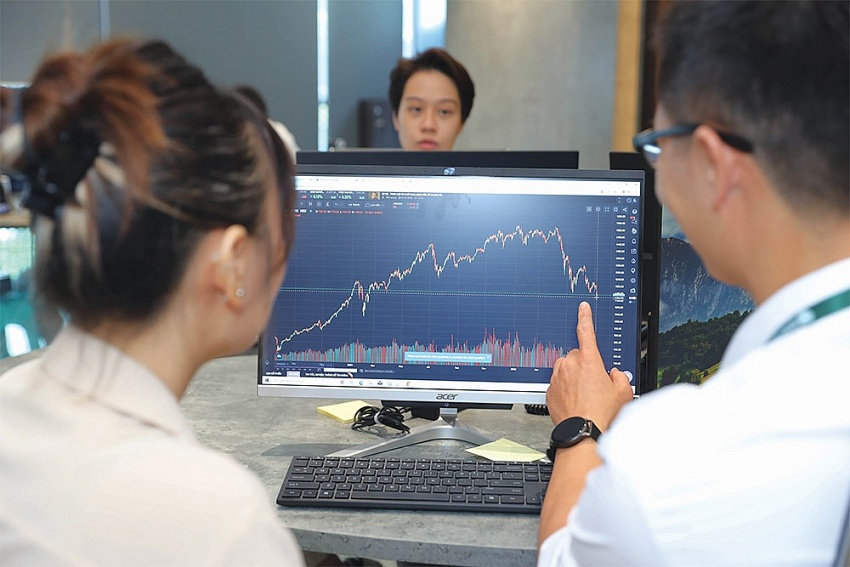How to build upon market dynamics
The global stock market is seeing numerous signs of recovery. What will serve as the key driving force for the market this year?
 |
| Tong Quoc Dat (left) and Trinh Van Ha - independent financial experts |
Dat: The prospect of interest rate cuts in 2024, anticipated to commence in June with three cuts expected throughout the year, is driving market sentiment. Moreover, a global decrease in inflation is foreseen, with recent energy price declines contributing to headline inflation figures such as the US’ 3.2 per cent, Germany’s 2.5 per cent, and the EU’s 2.8 per cent in February.
The current S&P 500 price-to-earnings (P/E) ratio stands at 20.8, below the peak of 22.6 in 2021. High unallocated funds in short-term secure investments, totalling $6 trillion in early March, signal potential shifts into alternative assets as interest rates are poised to decrease in 2024-2025.
Despite these factors, there are noteworthy concerns. While the revised global GDP forecast for 2024 is at 2.4 per cent, it remains modest compared to previous years, possibly limiting market growth following recent rapid increases.
Additionally, projections indicate unfavourable business earnings per share and elevated P/E ratio, compounded by Q4 profit margin declines, particularly in non-essential industries, reflecting consumer spending reductions and production cutbacks. However, market trust has improved compared to 2023, a pivotal factor in assessing overall market sentiment amid the challenges.
How do you assess Vietnam’s economic and stock market prospects for 2024?
Ha: Currently, deposit interest rates have declined even compared to during the pandemic, resulting in a significant reduction in lending rates, by an average of approximately 8-10 per cent for long-term loans. Additionally, the government’s new land law aims to address various legal issues in both civil and industrial real estate sectors.
As exports and imports contribute to approximately 20 per cent of our GDP, domestic business outlooks are closely tied to the international landscape. Stable employment leads to increased consumption and investment confidence, thereby driving overall economic growth.
Another important factor is foreign direct investment (FDI). Currently, FDI attraction remains robust, with positive trends in both newly registered and disbursed capital. In the first two years of 2024, total registered foreign-invested capital in Vietnam surged to nearly $4.29 billion, an almost 40 per cent on-year increase.
Which industries do you foresee benefiting from current market dynamics?
Ha: Vietnam continues to serve as a crucial link in the global supply chain, evident in the sustained increase in disbursed FDI, surpassing previous peaks in 2022-2023, and the recovery of registered capital, now prioritising production and logistics-oriented projects.
Industries that would likely benefit include industrial parks, logistics, warehousing, and energy, with a shift towards sustainable practices.
Additionally, the country anticipates a surge in consumer demand from key export markets like the United States, EU, and Japan, driving growth in industries such as wood, stone, and consumer goods manufacturing, along with the production of raw materials and chemical inputs for these goods.
Is the VN-Index still poised for upward momentum, and what factors will drive its recovery and growth?
Ha: The stock market often acts as a forward-looking indicator, reflecting expectations before actual economic changes occur. This process typically involves two stages: initial expectations and subsequent comparison with realised outcomes.
Currently, the market is largely aligning with expectations, particularly with the anticipated interest rate cuts by the Fed. In alignment with this, it seems to be that the worst has passed, with pricing already moved ahead a few steps.
The situation in Vietnam is similar, especially with the $6 trillion mentioned above, still hiding in short-term funds. As the Fed lowers interest rates, this pool of capital will likely flow into either actual business operations or the stock market, further propelling the VN-Index’s upward trajectory.
Although the VN-Index has seen significant growth recently, with a current P/E valuation of around 15, with indications of gradually decreasing and controlled inflation, coupled with global central banks easing monetary policies, there is considerable long-term growth potential for the stock market.
 |
| Market trust has improved compared to 2023, which is a pivotal factor in assessing overall sentiment Photo: Le Toan |
In addition to the enterprises’ business growth, what other factors should investors focus on to enhance investment efficiency and mitigate risks?
Dat: Tracking global GDP growth forecasts is crucial, due to its significant correlation with the overall stock market. Changes in GDP scenarios can influence the allocation of investment inflows and outflows, necessitating adjustments accordingly. It’s also important to monitor the evolving global inflation scenarios and to anticipate any supply disrupting events or fluctuations.
In addition, appropriately allocating capital across different market stages is vital. Increase your allocation during market downturns with reasonable adjustment rhythms, and reduce allocation during overvaluation and persisting macroeconomic challenges.
Lastly, I often advise investors to pursue long-term investment objectives by selecting industries and companies with promising long-term prospects and reasonable valuations, rather than engaging in frequent short-term trading strategies.
Ha: For new investors, establishing an investment roadmap is essential, given the inherent risks of the stock market. A prudent starting point would be investing in companies with strong financial positions and a favourable dividend payout ratio, typically around 9-10 per cent, which is almost doubling the current bank interest rates.
This approach offers a level of safety while allowing newcomers to familiarise themselves with the market and expand their knowledge of other listed enterprises.
Once a solid foundation is established, investors can gradually diversify into growth stocks, which offer higher yields but also entail increased risks. Simultaneously, honing technical analysis skills is advisable, enhancing confidence and proficiency in navigating the market landscape.
 | VIR hosting talk show on the stock market stability and sustainability VIR hosted a talk show on April 4 about the stock market's prospects in 2024. |
 | Stock market shows potential for growth Amidst a landscape of economic uncertainties, banking, retail, and real estate sectors are identified as beacons of growth, bolstered by strategic government interventions. |
What the stars mean:
★ Poor ★ ★ Promising ★★★ Good ★★★★ Very good ★★★★★ Exceptional
Related Contents
Latest News
More News
- Cake by VPBank posts strong gains in scale and efficiency leveraging AI focus (January 05, 2026 | 18:55)
- Banks step up listing plans in 2026 to strengthen capital and transparency (December 31, 2025 | 18:59)
- Ho Chi Minh City projects $10.5 billion remittance inflows in 2025 (December 31, 2025 | 18:58)
- New decree sharpens enforcement in securities market (December 31, 2025 | 18:53)
- Gold market reform advances as SBV receives applications for bullion production (December 30, 2025 | 12:07)
- EVN and AFD sign credit agreement for Vietnam’s first pumped storage hydropower plant (December 30, 2025 | 10:06)
- Techcombank Priority Visa Signature unlocks a higher standard of living (December 29, 2025 | 16:44)
- Tax sector wraps up 2025 and sets priorities for next year (December 25, 2025 | 14:00)
- A tipping point for digital and hybrid wealth management in Vietnam (December 23, 2025 | 13:33)
- $250 million deal targets women-owned SMEs, sustainable agriculture (December 22, 2025 | 17:40)

 Tag:
Tag:



















 Mobile Version
Mobile Version